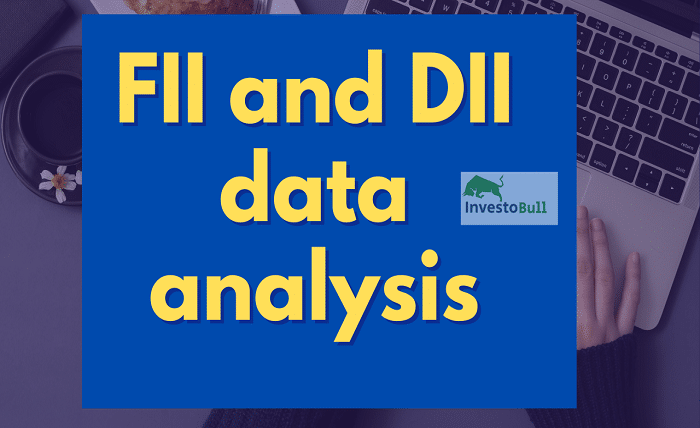FII and DII Data: A Comprehensive Guide for Investors

Introduction
In the world of stock market investing, understanding FII DII data is crucial for making informed decisions. FII, or Foreign Institutional Investors, and DII, or Domestic Institutional Investors, play a significant role in influencing market trends and determining stock prices. By analyzing FII DII data, investors can gain insights into the investment patterns of large institutions, both foreign and domestic. This guide will walk you through the basics of FII DII data, its importance in the market, and how to use it effectively to optimize your investment strategy.
What is FII DII Data?
To understand FII DII data, it’s important to first know who these investors are. Foreign Institutional Investors (FIIs) are organizations outside the country that invest in local stock markets, bringing in significant foreign capital. Domestic Institutional Investors (DIIs), on the other hand, are local entities such as banks, insurance companies, and mutual funds investing within the country. FII DII data reflects the buying and selling activity of these two major investor groups, providing valuable insights into market sentiment and investment patterns.
The Importance of FII DII Data in the Stock Market
FII DII data is crucial because it shows the flow of funds from both foreign and domestic institutions, which often drives market movements. FII DII data influences stock prices, market sentiment, and even the economic outlook of the country. When FIIs are net buyers, it indicates confidence in the country’s economic stability, while DII buying suggests local optimism. Therefore, monitoring FII DII data helps investors understand the broader market dynamics and align their strategies accordingly.
How FII DII Data Impacts Market Sentiment
The buying and selling patterns shown in FII DII data play a significant role in shaping market sentiment. When FII data shows heavy buying, it often signals strong confidence from foreign investors, leading to a bullish market sentiment. Conversely, when FIIs are net sellers, it can indicate risk aversion and trigger a bearish outlook. Similarly, DII data reflects local investors’ confidence in the market. Thus, FII DII data serves as a barometer for investor sentiment and can be an early indicator of market trends.
Analyzing FII DII Data for Investment Decisions
To effectively use FII DII data, investors need to analyze the trends over different timeframes. For instance, a consistent pattern of FII buying may indicate a strong inflow of foreign capital, which can drive up stock prices. By examining FII DII data alongside economic indicators and corporate earnings, investors can make well-informed decisions. Using technical analysis and combining it with FII DII data can also help spot short-term market opportunities and long-term investment trends.
The Relationship Between FII DII Data and Market Volatility
One of the key aspects of FII DII data is its influence on market volatility. Large-scale buying or selling by FIIs can lead to sudden market fluctuations, as foreign capital is highly sensitive to global economic events. For example, geopolitical tensions or changes in interest rates abroad can lead to abrupt shifts in FII activity. Conversely, DII activity is often more stable, acting as a counterbalance to FII-driven volatility. Understanding the relationship between FII DII data and volatility can help investors mitigate risks and manage their portfolios effectively.
How Global Economic Factors Affect FII DII Data
FII DII data is often influenced by global economic factors, such as changes in interest rates, currency exchange rates, and geopolitical developments. When foreign markets are performing well, FIIs are likely to invest more in emerging economies, boosting FII data positively. Conversely, if global economic conditions deteriorate, FIIs might pull out funds, leading to a downturn in FII data. Being aware of these factors allows investors to anticipate shifts in FII DII data and adapt their strategies accordingly.
The Role of FII DII Data in Long-Term Market Trends
Analyzing FII DII data over the long term provides insights into structural trends within the market. For instance, a sustained period of FII inflows suggests confidence in the country’s long-term economic growth, which can drive a multi-year bull market. Similarly, consistent DII investments reflect local support for the market’s health. Monitoring long-term FII DII data trends helps investors stay ahead of broader economic cycles, positioning them for sustained growth and stability in their portfolios.
Practical Strategies for Using FII DII Data in Your Portfolio
To leverage FII DII data effectively, investors should develop practical strategies based on data analysis. For instance, tracking daily FII DII data can provide insights into short-term trading opportunities, while analyzing monthly or quarterly data can inform longer-term investment decisions. Additionally, investors can use FII DII data to diversify their portfolios, balancing sectors favored by FIIs with those preferred by DIIs. Using FII DII data as part of a comprehensive investment strategy enables investors to make more informed and strategic choices.
Common Tools and Platforms for Tracking FII DII Data
Accessing accurate FII DII data is essential for making informed decisions. There are several online platforms, including financial websites, brokerage platforms, and stock market analysis tools, that provide updated FII DII data. Many platforms offer charts and historical data, allowing investors to track trends and compare FII DII data over time. Popular tools such as Moneycontrol, NSE India, and BSE India provide reliable and real-time FII DII data. By using these tools, investors can stay up-to-date with the latest FII DII trends and align their strategies accordingly.
Limitations of FII DII Data and How to Overcome Them
While FII DII data is valuable, it has certain limitations. FII DII data reflects only institutional activity, meaning it may not fully capture the impact of retail investors or smaller market movements. Additionally, short-term FII DII data can be volatile and subject to rapid changes due to external factors. To overcome these limitations, investors should combine FII DII data with other market indicators, such as earnings reports, macroeconomic data, and technical analysis. By adopting a holistic approach, investors can gain a more accurate picture of market trends and improve their decision-making.
Conclusion
FII DII data is a powerful tool for investors seeking to navigate the complexities of the stock market. By understanding the roles of Foreign Institutional Investors and Domestic Institutional Investors, investors can gain insights into market sentiment, volatility, and long-term trends. While FII DII data alone does not guarantee investment success, it provides valuable guidance for informed decision-making. Combining FII DII data with other economic indicators and investment strategies can help investors optimize their portfolios, mitigate risks, and capitalize on market opportunities. Ultimately, mastering FII DII data can be a game-changer for those looking to succeed in the dynamic world of stock market investing.
FAQs
1. What is FII DII data?
FII DII data refers to the buying and selling activities of Foreign Institutional Investors (FIIs) and Domestic Institutional Investors (DIIs) in the stock market. This data provides insights into the investment patterns of these large institutions, influencing market sentiment and stock prices.
2. How does FII DII data impact market trends?
FII DII data significantly impacts market trends, as FIIs and DIIs control large volumes of capital. When FII data shows heavy buying, it often creates bullish market sentiment, while DII buying indicates local investor confidence. Monitoring FII DII data helps investors predict market direction.
3. How can investors use FII DII data in their strategies?
Investors can use FII DII data to make informed decisions by analyzing buying and selling trends of institutional investors. Short-term FII DII data can guide trading strategies, while long-term data provides insights into broader market trends, helping investors manage risk and optimize portfolios.
4. Which platforms provide reliable FII DII data?
Several platforms offer real-time FII DII data, including Moneycontrol, NSE India, and BSE India. These tools provide charts, historical data, and trend analysis, enabling investors to track institutional investment patterns and align their strategies accordingly.
5. What are the limitations of relying solely on FII DII data?
While FII DII data is valuable, it has limitations. It may not fully capture retail investor activity or small market shifts and can be volatile in the short term. Combining FII DII data with other economic indicators offers a more comprehensive view for better decision-making.




